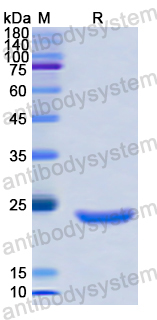Catalog No.
YHG68901
Expression system
E. coli
Species
Homo sapiens (Human)
Protein length
Met1-Ala198
Predicted molecular weight
24.67 kDa
Nature
Recombinant
Endotoxin level
Please contact with the lab for this information.
Purity
>90% as determined by SDS-PAGE.
Accession
Q14008
Applications
ELISA, Immunogen, SDS-PAGE, WB, Bioactivity testing in progress
Form
Lyophilized
Storage buffer
Lyophilized from a solution in PBS pH 7.4, 0.02% NLS, 1mM EDTA, 4% Trehalose, 1% Mannitol.
Reconstitution
Reconstitute in sterile water for a stock solution. A copy of datasheet will be provided with the products, please refer to it for details.
Shipping
In general, proteins are provided as lyophilized powder/frozen liquid. They are shipped out with dry ice/blue ice unless customers require otherwise.
Stability and Storage
Use a manual defrost freezer and avoid repeated freeze thaw cycles. Store at 2 to 8°C for frequent use. Store at -20 to -80°C for twelve months from the date of receipt.
Alternative Names
Cytoskeleton-associated protein 5, CKAP5, Colonic and hepatic tumor overexpressed gene protein, KIAA0097, Ch-TOG
CKAP5 promotes progression and cisplatin resistance in esophageal squamous cell carcinoma via microtubule-mediated YAP activation., PMID:40404119
CKAP5 deficiency induces premature ovarian insufficiency., PMID:40252251
Pathogenic variants of TUBB8 cause oocyte spindle defects by disrupting with EB1/CAKP5 interactions and potential treatment targeting microtubule acetylation through HDAC6 inhibition., PMID:39834092
The TOG5 domain of CKAP5 is required to interact with F-actin and promote microtubule advancement in neurons., PMID:39504455
CKAP5 stabilizes CENP-E at kinetochores by regulating microtubule-chromosome attachments., PMID:38424231
Male meiotic spindle poles are stabilized by TACC3 and cKAP5/chTOG differently from female meiotic or somatic mitotic spindles in mice., PMID:38413710
The spindle protein CKAP2 regulates microtubule dynamics and ensures faithful chromosome segregation., PMID:38381793
Cytoskeleton crosstalk: Casting stable actin bundles with dynamic microtubule molds., PMID:38262365
PSMA7 promotes the malignant proliferation of esophageal cancer., PMID:38173490
CKAP5 enables formation of persistent actin bundles templated by dynamically instable microtubules., PMID:38086388
Delivery of Therapeutic RNA to the Bone Marrow in Multiple Myeloma Using CD38-Targeted Lipid Nanoparticles., PMID:37171801
Therapeutic gene silencing of CKAP5 leads to lethality in genetically unstable cancer cells., PMID:37018392
TACC3-ch-TOG interaction regulates spindle microtubule assembly by controlling centrosomal recruitment of γ-TuRC., PMID:36790370
Microtubule nucleation and γTuRC centrosome localization in interphase cells require ch-TOG., PMID:36702836
The mechanism of acentrosomal spindle assembly in human oocytes., PMID:36395215
The TOG protein Stu2 is regulated by acetylation., PMID:36084134
Competing endogenous RNA analysis reveals the regulatory potency of CKAP5 in HPV+ HNSCC., PMID:35710876
Bioinformatics-based screening of key genes between maternal preeclampsia and offspring schizophrenia., PMID:35597180
CircZNF609 as a prototype to elucidate the biological function of circRNA-mRNA interactions., PMID:35434270
Oncogenic Fusions in Gliomas: An Institutional Experience., PMID:35347013
Circular RNA ZNF609/CKAP5 mRNA interaction regulates microtubule dynamics and tumorigenicity., PMID:34942120
Molecular insight into how γ-TuRC makes microtubules., PMID:34297125
Tau, XMAP215/Msps and Eb1 co-operate interdependently to regulate microtubule polymerisation and bundle formation in axons., PMID:34228717
Integrated profiling identifies ITGB3BP as prognostic biomarker for hepatocellular carcinoma., PMID:33974527
Analysis of m6A RNA Methylation-Related Genes in Liver Hepatocellular Carcinoma and Their Correlation with Survival., PMID:33540684
Defining endogenous TACC3-chTOG-clathrin-GTSE1 interactions at the mitotic spindle using induced relocalization., PMID:33380489
chTOG is a conserved mitotic error correction factor., PMID:33377866
Tyrosine phosphorylation regulates hnRNPA2 granule protein partitioning and reduces neurodegeneration., PMID:33349959
Roles of TOG and jelly-roll domains of centrosomal protein CEP104 in its functions in cilium elongation and Hedgehog signaling., PMID:32820051
Identification of Key Biological Processes, Pathways, Networks, and Genes with Potential Prognostic Values in Hepatocellular Carcinoma Using a Bioinformatics Approach., PMID:32598174
TACC3 Regulates Microtubule Plus-End Dynamics and Cargo Transport in Interphase Cells., PMID:31914393
Three miRNAs cooperate with host genes involved in human cardiovascular disease., PMID:31464655
Structures of TOG1 and TOG2 from the human microtubule dynamics regulator CLASP1., PMID:31323070
GPR124 regulates microtubule assembly, mitotic progression, and glioblastoma cell proliferation., PMID:31058365
Insulin Induces Microtubule Stabilization and Regulates the Microtubule Plus-end Tracking Protein Network in Adipocytes., PMID:31018989
Systematic proteomics of endogenous human cohesin reveals an interaction with diverse splicing factors and RNA-binding proteins required for mitotic progression., PMID:31010829
XMAP215 promotes microtubule-F-actin interactions to regulate growth cone microtubules during axon guidance in Xenopuslaevis., PMID:30890650
Microtubule Plus End Dynamics - Do We Know How Microtubules Grow?: Cells boost microtubule growth by promoting distinct structural transitions at growing microtubule ends., PMID:30730055
Payload of T-DM1 binds to cell surface cytoskeleton-associated protein 5 to mediate cytotoxicity of hepatocytes., PMID:30647854
GLI2 promotes cell proliferation and migration through transcriptional activation of ARHGEF16 in human glioma cells., PMID:30305138
Specificity of RNAi, LNA and CRISPRi as loss-of-function methods in transcriptional analysis., PMID:29860520
In vivo mitotic spindle scaling can be modulated by changing the levels of a single protein: the microtubule polymerase XMAP215., PMID:29851557
XMAP215 is a microtubule nucleation factor that functions synergistically with the γ-tubulin ring complex., PMID:29695792
Solution NMR assignment of the C-terminal domain of human chTOG., PMID:29582386
Local control of intracellular microtubule dynamics by EB1 photodissociation., PMID:29379139
Evaluating the associations between human circadian rhythms and dysregulated genes in liver cancer cells., PMID:29250165
Structural insight into the XTACC3/XMAP215 interaction from CD and NMR studies on model peptides., PMID:28922450
AURKA mRNA expression is an independent predictor of poor prognosis in patients with non-small cell lung cancer., PMID:28588715
BDE-99 impairs differentiation of human and mouse NPCs into the oligodendroglial lineage by species-specific modes of action., PMID:28317842
Multivalent Molecules as Modulators of RNA Granule Size and Composition., PMID:28242011

